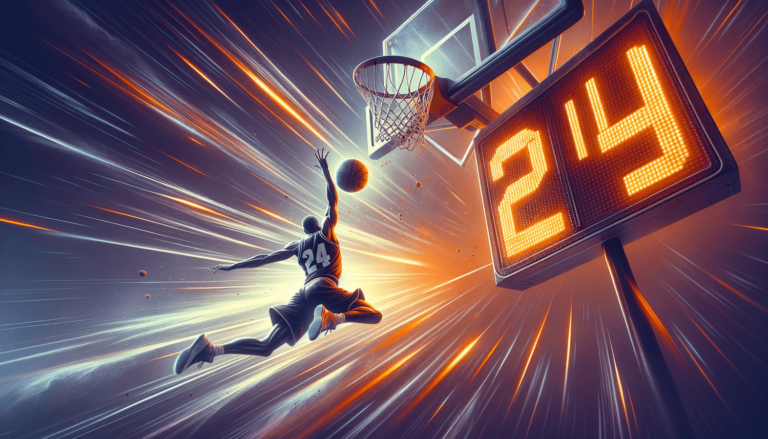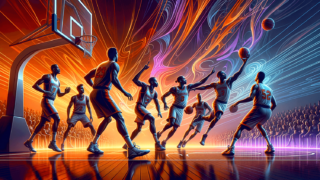
24-Second Shot Clock Violation in Basketball
Written by: Basketball Universe
Last updated:

Imagine the game of basketball without time constraints, where teams pass the ball endlessly, and excitement gives way to boredom. To spare fans from this tedious nightmare, the 24-second shot clock rule was introduced! 🕒💥Welcome to our in-depth dive into the fascinating world of the “24-Second Shot Clock Violation” in basketball. Fasten your seatbelts, hoops fans, as we explore the origins, mechanics, and impact this rule has had on the game you love!
24-Second Shot Clock Violation in Basketball
The 24-second shot clock violation in basketball is a rule that prevents a team from possessing the ball for more than 24 seconds without attempting a shot. The clock resets once a shot attempt hits the rim or a change in possession happens, ensuring a fast-paced game and preventing stalling tactics. If a team fails to take a shot before the shot clock expires, it results in a turnover, giving the opposing team possession of the ball.
Origins of the Shot Clock
Before diving into the intricacies of the 24-second shot clock violation, let’s take a walk down memory lane and understand how the rule came into existence. The brainchild of Syracuse Nationals owner Danny Biasone and general manager Leo Ferris, the shot clock was introduced in the 1954-55 NBA season to combat stalling tactics and increase the speed of the game. The implementation of the 24-second shot clock was a game-changer in basketball, eventually leading to the high-scoring, fast-paced action we enjoy today.
How the 24-Second Shot Clock Works
Curious about the nuts and bolts of the 24-second shot clock? Let’s break it down step by step:
1. Beginning the countdown
When a team gains possession of the ball, the 24-second shot clock timer starts ticking. Anytime the team begins a new possession, either from a missed shot, a turnover, or the start of a period, the shot clock resets to 24 seconds.
2. Shot attempts and resetting the clock
If a team attempts a shot and the ball hits the rim, the shot clock resets to 24 seconds, allowing the team to retain possession and attempt another shot. Remember, simply releasing the ball before the clock expires isn’t enough; the shot must hit the rim.
3. Change of possession
If a team loses possession, either via a turnover or a successful shot, the shot clock timer stops and resets to 24 seconds once the opposing team gains possession.
Exceptions to the Rule
Of course, like many basketball rules, there are some exceptions to the 24-second shot clock rule. Knowing these subtle nuances can help you better appreciate the clock’s impact on player strategy:
1. Offense-initiated timeouts
If an offensive team calls for a timeout, the shot clock doesn’t reset to a full 24 seconds. Instead, if 14 or more seconds remain on the shot clock, it stays as-is. However, if less than 14 seconds remain, the shot clock resets to 14 seconds following the timeout.
2. Defensive deflections
When the defensive team causes the ball to go out of bounds or deflects the ball, the shot clock does not reset. The shot clock timer remains the same as it was before the deflection occurred.
3. Successful basket interference or goaltending
If the defensive team commits basket interference or goaltending on a shot attempt, the shot attempt is considered successful, and the shot clock resets as if the shot had been made.
Team Strategies for Dealing with the Shot Clock
The 24-second shot clock is an ever-present factor in how basketball teams strategize and approach offensive and defensive situations. Both sides of the court constantly assess their playmaking in the context of shot clock management:
1. Exploiting opportunities on offense
Quick passes and ball movement are essential to finding open shots within the 24-second window. Teams may force shots earlier in the clock to capitalize on unexpected openings, or utilize a planned play to create an open shot attempt later in the possession.
2. Managing tempo
A crucial aspect of shot clock management is dictating a game’s tempo. Some teams may adopt a slower offensive strategy, running down the shot clock to limit fast breaks and slow the opponents’ scoring pace. Conversely, fast-paced teams exploit quick shot attempts and rapid possessions to create more scoring chances and pressure opponents.
3. Defensive disruption
Pressuring the ball handler, denying passes, and limiting shot opportunities are essential defensive tactics that can cause violations. By disrupting an opponent’s offensive rhythm and forcing them to make hurried, low-percentage shots or committing a shot clock violation, the defense regains possession and stifles scoring opportunities.
Consequences of Shot Clock Violations
Now that you understand how the 24-second shot clock violation works, let’s discuss its consequences on the game:
1. Turnover and change of possession
The primary consequence of a shot clock violation is the offending team losing possession of the ball. This turnover allows the defensive team to regain possession, driving opportunities for fast breaks and scoring chances.
2. Disrupted offensive flow
Shot clock violations can disrupt a team’s offensive rhythm and confidence. Repeated violations may signal the need for adjustments in offensive strategy or further emphasize focus on executing proper plays.
3. Penalties in the final two minutes
In the last two minutes of the game, the consequences of a shot clock violation differ slightly. In these situations, if the offensive team secures an offensive rebound after a missed shot and the shot clock expires, the defensive team receives the ball at the nearest sideline or baseline, giving them more favorable court positioning.
Famous Shot Clock Violation Moments
Here are some noteworthy instances in basketball history where the 24-second shot clock violation played a pivotal role:
1. The Shot Clock Game
In the 1993 NBA playoffs, the Charlotte Hornets employed a “shot clock game” strategy against the Boston Celtics. By running down the shot clock in each possession, the Hornets drained the game’s tempo and frustrated the high-scoring Celtics, ultimately securing an unexpected victory.
2. Tim Duncan’s near-miss
During Game 6 of the 2013 NBA Finals, Tim Duncan narrowly missed a shot that could have propelled the San Antonio Spurs to a title-clinching win. With the Spurs up by 3 and just over a minute remaining in regulation, Duncan missed a shot over Shane Battier as the shot clock expired. The Miami Heat would later tie the game with a Ray Allen 3-pointer, eventually winning in overtime and securing the championship.
Shot Clock’s Impact Beyond the NBA
While the 24-second shot clock is now synonymous with the NBA, various leagues worldwide have adopted their own shot clock rules:
1. FIBA and Euroleague
FIBA and Euroleague regulations both follow the same 24-second shot clock rule as the NBA. This standardization helps maintain a consistent speed of play in international competitions.
2. College Basketball
NCAA men’s college basketball adopted a 35-second shot clock in 1985, later reducing it to 30 seconds in the 2015-16 season. Similarly, women’s college basketball introduced a 30-second shot clock in 1970-71, aligning with men’s basketball in the 2015-16 season.
3. High School and Youth Leagues
Many high school and youth basketball leagues have also implemented shot clocks, varying in length from 24 to 35 seconds, depending on the level of play and local regulations.
Changing Times: Debating the Shot Clock
As basketball evolves, discussions surrounding shot clock regulations continue. Some proponents argue for a shorter shot clock across all levels of play, while others believe the current shot clock lengths provide adequate strategic nuance. Despite these debates, one thing is clear: the introduction of the shot clock in basketball has had an immeasurable impact on the game, shaping strategies, influencing legendary moments, and ensuring fans are treated to exhilarating matchups each time they cheer on their favorite teams.
24-Second Shot Clock in the G-League and WNBA
Similar to the NBA and other international leagues, the G-League and the WNBA have also adopted the 24-second shot clock rule. This helps provide a unified and cohesive experience for players and fans alike, ensuring a consistent pace of play and contributing to the spirited action on the court.
Clutch Shot Clock Violation Moments
Apart from allowing teams to execute their strategies better, the 24-second shot clock can also create memorable moments in the game. Several games have witnessed thrilling last-second plays where teams barely beat the shot clock or got unfortunate violations. Here are some examples:
1. Patrick Ewing’s Buzzer Beater
During the 1990 Eastern Conference Semifinals between the New York Knicks and the Detroit Pistons, Patrick Ewing hit a game-winning shot against the buzzer as the shot clock expired. This iconic play sealed the victory for the Knicks, etching Ewing’s name in the annals of basketball history.
2. The Fisher 0.4 Second Shot
One of the most iconic shots in NBA playoffs history, Derek Fisher’s 0.4-second shot against the San Antonio Spurs in the 2004 Western Conference Semifinals, prevented a shot clock violation. Fisher’s quick release buzzer beater, under immense pressure, showcased the importance of clutch shot-making in high-stakes basketball.
Shot Clock Variations in Celebrity and Charity Games
When celebrities and athletes come together to participate in charity or other exhibition basketball games, they often humorously modify the shot clock rules. For instance, they may implement a “10-second shot clock” to increase the pace and entertainment value, providing fans with amusing displays of basketball skills (or a lack thereof).
The Future of Shot Clock Technology
As we look towards the future, technology advancements promise to improve the accuracy and functionality of shot clocks in basketball. LED displays, precision timers, and even visual indicators for players and referees are some of the innovations that will further enhance this integral aspect of the sport.
Role of the Shot Clock Operator
A lesser-known but essential part of the game, the shot clock operator is responsible for starting, stopping, and resetting the shot clock according to the on-court events. To ensure seamless coordination between the referees and the game, these operators must be diligent, attentive, and knowledgeable about basketball rules, including all aspects related to the shot clock.
Frequently Asked Questions (FAQ)
Curious to learn more about the 24-second shot clock and related rules in basketball? Here’s a list of frequently asked questions to further expand your knowledge on this topic:
1. Why was the 24-second shot clock introduced?
Before the shot clock, teams in the NBA could stall games by holding onto the ball for long periods without taking a shot. The shot clock was introduced in 1954 to speed up gameplay, increase scoring opportunities, and create a more engaging experience for fans.
2. What happens if a team shoots and scores after the shot clock has expired?
If a team releases a shot after the shot clock expires and it goes in, the basket will not count, and the opposing team gets possession of the ball.
3. Can a team win a game by stalling with the ball and waiting for the shot clock to expire?
A team cannot win a game by stalling as they risk committing a shot clock violation if they don’t attempt a shot within the 24-second window. Violations result in turnovers, giving the opposing team possession and the opportunity to catch up in score or secure the win.
4. How do other leagues differ from the NBA in terms of shot clock rules?
The NBA, FIBA, and Euroleague all use a 24-second shot clock. However, NCAA men’s and women’s college basketball employ a 30-second shot clock. High school and youth leagues typically use shot clocks ranging from 24 to 35 seconds, depending on the level of play.
5. Do other sports have similar shot clock rules?
Several sports incorporate shot clock rules to maintain pace and overall flow. Lacrosse, water polo, and hockey are some sports that employ similar shot clock systems to prevent stalling tactics and sustain the overall tempo of gameplay.
6. How do referees determine if a shot was released before the shot clock expired?
Referees rely on their vision and experience to judge if a shot was released before the shot clock expired. Additionally, they may utilize video reviews and shot clock buzzer sounds to verify their decisions during critical game moments.
7. Does the shot clock reset after an intentional foul?
An intentional foul does not reset the shot clock. If there is a foul on a shot attempt and the ball remains with the offending team after a free throw or inbound play, the shot clock will retain its prior time or reset to 14 seconds, depending on the time remaining when the foul was called.
8. In which basketball situations is the shot clock turned off?
The shot clock is turned off during the final possession of a period if there is less time remaining in the period than on the shot clock. This allows teams to take the final shot or possession without worrying about a shot clock violation.
9. How do teams optimize their play to work within the constraints of the shot clock?
Teams use a variety of strategies to optimize their play within shot clock constraints, including quick passes, effective ball movement, pressuring defense, and exploiting openings. They may also employ clock management techniques to control the tempo of the game and maximize scoring opportunities.
10. How is the shot clock timer displayed on the court?
Each basketball court features an electronic shot clock display located above the backboard or along the scorer’s table, depending on the venue. This display is clearly visible to players, referees, and coaches, helping them make decisions based on the remaining time on the shot clock.
Featured Posts
- No pillar pages found.





